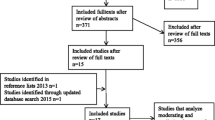Abstract
An empirical study of the effectiveness of an eight-week children's bereavement psychotherapy group was undertaken. Children, aged 7–11, who had a parent and/or sibling die were initially assigned to either a treatment group or a waiting list control group and followed over an eight-week period. Participation in the experimental group was associated with a significant decrease in symptomatology, as assessed by multiple measures using multiple sources. Despite a small sample, the intervention was sufficiently powerful to suggest the use of short-term group therapy to help children cope with the death of a parent and/or sibling.
Similar content being viewed by others
References
Achenbach, R. M. (1978). The child behavior profile: I. Boys aged 6–11.Journal of Consulting and Clinical Psychology, 46, 478–488.
Achenbach, R. M. & Edelbrock, C. S. (1979). The child behavior profile: II. Boys aged 12–16 and girls aged 6–11 and 12–16.Journal of Consulting and Clinical Psychology, 47, 223–233.
Achenbach, R. M. & Edelbrock, C. (1983a).Manual for the child behavior checklist and revised child behavior profile. Burlington, Vermont: Department of Psychiatry, University of Vermont.
Achenbach, R. M. & Edelbrock, C. S. (1983b).Manual for the teacher's report form and teacher version of the child behavior profile. Burlington, Vermont: Department of Psychiatry, University of Vermont.
Atwood, V. A. (1984). Children's concepts of death: A descriptive study.Child Study Journal, 14, 11–29.
Berlinsky, E. B. (1982).Parental Death and Psychological Development, Massachusetts: Lexington Books.
Bowlby, J. (1980).Attachment and Loss: Sadness and Depression (Vol. 3). New York: Basic Books.
Burgess-Kohn, J. (1978). A death in the family.Parent's Magazine, 53, 72–74.
Davis, C. B. (1989). The use of art therapy and group process with grieving children. Special issue: The death of a child: III.Issues in Comprehensive Pediatric Nursing, 12, 269–280.
Furman, E. A. (1974).A child's parent dies: Studies in childhood bereavement. New Haven, Conn.: Yale University Press.
Greenberg, L. I. (1975). Therapeutic grief work with children.Social Casework, July, 396–403.
Johnson, L. F., Rudolf, L. A. & Hartman, J. R. (1979). Helping the family cope with childhood cancer.Psychosomatics, 20, 241–251.
Kaffman, M. & Elizur, E. (1983). Bereavement responses of kibbutz and non-kubbutz children following the death of a father.Journal of Child Psychology and Psychiatry, 24, 435–442.
Kazdin, A. E. (1988).Child psychotherapy: Developing and identifying effective treatments. Pergamon General Psychology Series.
Kovacs, M. (1985). The Children's Depression Inventory (CDI).Psychopharmacology Bulletin, 21, 995–999.
Krupnick, J. L. & Solomon, F. (1987). Death of a parent or sibling during childhood. In J. Bloom-Feshbach & S. Bloom-Feshbach (Eds.).The psychology of separation and loss (pp. 345–371). San Francisco: Jossey Bass.
Lambert, M. J., Shapiro, D., & Bergin, A. E. (1986). The effectiveness of psychotherapy. S. L. Garfield & A. E. Bergin (Eds.).Handbook of psychotherapy and behavior change (3rd ed.). New York: John Wiley & Sons.
Markusen, E. & Fulton, R. (1971). Childhood bereavement and behavior disorders: A critical review.Omega, 2, 107–116.
Masterman, S. H. & Reams, R. (1988). Support groups for bereaved pre-school and school age children.American Journal of Orthopsychiatry, 58, 562–570.
Matter, D. E. & Matter, R. M. (1982). Developmental sequences in children's understanding of death with implications for counselors.Elementary School Guidance and Counseling, December, 112–119.
Moss, S. Z. & Moss, M. S. (1973). Separation as a death experience.Child Psychiatry and Human Development, 3, 187–194.
Parkes, C. M. (1976). Determinants of outcome following bereavement.Omega, 6, 303–323.
Rabkin, J. F. & Streuning, E. L. (1976). Life events, stress, and illness.Science, 194, 1013–1020.
Reilly, T. P., Hasazi, J. E., & Bond, L. A. (1983). Children's conceptions of death and personal mortality.Journal of Pediatric Psychology, 8, 21–31.
Rosenthal, P. A. (1980). Short-term family therapy and pathological grief resolution with children and adolescents.Family Process, 19, 1980.
Rutter, M. (1966).Children of Sick Parents. London: Oxford University Press.
Scheidlinger, S. (1984). Short-term group psychotherapy for children: An overview.International Journal of Group Psychotherapy, 34, 573–585.
Schoenberg, M. B. (Ed.). (1980).Bereavement counseling: A multidisciplinary handbook. New York: Greenwood Press.
Schonfeld, D. J. (1989). Crisis intervention for bereavement support: A model of intervention in the children's school.Clinical Pediatrics, 28, 27–33.
Segal, R. M. (1984). Helping children express grief through symbolic communication.The Journal of Contemporary Social Work, December, 590–599.
Silveira, W. R. & Trafford, G. (1988).Children need groups. A practical manual for group work with young children. Aberdeen University Press, Aberdeen, Scotland.
Slavin, L. A. (1981). Evolving psychosocial issues in the treatment of childhood cancer: A review. In G. P. Koocher & J. E. O'Malley (Eds.)The Damocles Syndrome: The psychosocial consequences of surviving childhood cancer. New York: McGraw Hill.
Tramontana, M. G. & Sherrets, S. D. (1988). Assessing outcome in disorders of childhood and adolescence. In Lambert, M. J., Christensen, E. R. & DeJulio, S. S. (Eds.).The assessment of psychotherapy outcome. (pp. 406–449). New York: Wiley.
Van Eerdewegh, M. M., Bieri, M. D., Parrilla, R. H., & Clayton, P. J. (1982). The bereaved child.British Journal of Psychiatry, 140, 23–20.
Vida, S. & Grizenko, N. (1989). DSM III-R and the phenomenology of childhood bereavement: A review.Canadian Journal of Psychiatry, 34, 148–155.
Warmbrod, M. E. (1986). Counseling bereaved children: Stages in the process.The J. of Contemporary Social Work, June, 351–358.
Worden, J. W. (1982).Grief counseling and grief therapy, New York: Springer.
Yalom, I. D. (1980).Existential psychotherapy. New York: Basic Books.
Author information
Authors and Affiliations
Additional information
The research reported here was originally included in a dissertation written in fulfillment of the requirements for a Ph.D. at Brigham Young University. We wish to acknowledge the helpful suggestions and support from Dr. John Flora-Tostado, Dr. John Lyons, Dr. Joanne Marengo and the participants in the Post-doctoral Research Seminar at Northwestern Memorial Hospital.
Dr. Lambert is a Professor of Psychology, Department of Psychology, Brigham Young University.
Rights and permissions
About this article
Cite this article
Tonkins, S.A.M., Lambert, M.J. A treatment outcome study of bereavement groups for children. Child Adolesc Soc Work J 13, 3–21 (1996). https://doi.org/10.1007/BF01876592
Issue Date:
DOI: https://doi.org/10.1007/BF01876592




